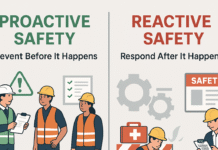
Unsafe Act Vs Unsafe Condition
Unsafe Act Vs Unsafe Condition : In the world of occupational safety, distinguishing between an unsafe act and an unsafe condition is pivotal. These terms are often interchanged, but they represent distinct aspects of workplace safety. To gain a comprehensive understanding, let’s delve into the disparities between unsafe acts and unsafe conditions, highlighting their significance in ensuring a secure work environment.
Introduction
Workplace safety is of paramount importance in every industry. It not only ensures the well-being of employees but also contributes to enhanced productivity and reduced operational costs. In the realm of safety management, two terms often arise – “unsafe acts” and “unsafe conditions.” To make workplaces safer, it’s crucial to distinguish between the two and address them effectively.
Defining Unsafe Acts
Unsafe acts refer to actions or behaviors by employees that deviate from established safety protocols and guidelines. These actions can be intentional or unintentional, but they all pose a risk to the individual and those around them. Understanding the types of unsafe acts is essential for recognizing and rectifying them.
Types of Unsafe Acts
Reckless Behavior
Reckless behavior encompasses actions like horseplay, using equipment improperly, or failing to wear personal protective equipment (PPE). These actions can result from a lack of awareness or a disregard for safety measures.
Inadequate Training
Employees may perform unsafe acts due to insufficient training. When workers don’t fully understand the correct procedures, they are more likely to engage in actions that put themselves and others at risk.
Disregard for Safety Procedures
Some individuals may knowingly ignore safety procedures, thinking they can cut corners without consequences. This disobedience to established safety guidelines can lead to accidents and injuries.
Identifying Unsafe Conditions
Unsafe conditions, on the other hand, are physical or environmental factors within the workplace that increase the likelihood of accidents or injuries. These conditions are often beyond an employee’s control and require proactive management.
Common Unsafe Conditions
Poor Lighting
Inadequate lighting can make it difficult for employees to identify hazards and navigate safely. Dark areas in a workplace can lead to trips, falls, and other accidents.
Faulty Equipment
Machinery or tools that are not properly maintained can malfunction, posing a significant risk to employees. Regular equipment maintenance is crucial in preventing accidents.
Slippery Surfaces
Wet or oily surfaces without appropriate non-slip measures can result in slips and falls. Such conditions can be especially hazardous in areas with high foot traffic.
Consequences of Unsafe Acts and Conditions
Both unsafe acts and conditions can have severe consequences. Unsafe acts can lead to immediate accidents and injuries, while unsafe conditions create an environment where accidents are more likely to occur. These consequences can include injuries, fatalities, damaged equipment, and financial losses.
Prevention and Mitigation Strategies
To ensure a safe work environment, it’s vital to address both unsafe acts and conditions through various strategies.
Training and Education
Proper training and ongoing education are essential to minimize unsafe acts. Employees should be well-informed about safety procedures and the consequences of non-compliance.
Regular Maintenance
Preventing unsafe conditions requires a commitment to regular maintenance of equipment and facilities. This proactive approach reduces the likelihood of accidents caused by faulty equipment or infrastructure.
Safety Inspections
Regular safety inspections help identify and rectify both unsafe acts and conditions. These inspections should be conducted by trained personnel to ensure thorough evaluations.
The Collaborative Approach
Ultimately, addressing workplace safety necessitates a collaborative effort. Employees, employers, and safety professionals must work together to identify and rectify unsafe acts and conditions. Open communication, reporting mechanisms, and a culture of safety are fundamental in achieving this goal.
Conclusion
In summary, understanding the difference between unsafe acts and unsafe conditions is crucial for maintaining workplace safety. Unsafe acts are actions or behaviors by employees that deviate from safety guidelines, while unsafe conditions refer to physical factors that create a hazardous environment. By recognizing, addressing, and preventing both, organizations can foster a culture of safety and protect their most valuable asset – their employees.
Difference Between Hazard Risk Accident Incident and Near Miss
FAQs
1. What are some examples of unsafe acts in the workplace?
Unsafe acts in the workplace can include actions like not wearing proper personal protective equipment (PPE), engaging in horseplay, failing to follow established safety procedures, using equipment improperly, and disregarding warning signs. These actions can pose risks to both the individual and their colleagues.
2. How can inadequate training contribute to unsafe acts?
Inadequate training can contribute to unsafe acts by leaving employees unaware of proper safety procedures and guidelines. When workers do not have the knowledge and skills necessary to perform their tasks safely, they are more likely to make mistakes or engage in actions that put themselves and others at risk.
3. What are the consequences of ignoring safety procedures?
Ignoring safety procedures can have serious consequences, including accidents, injuries, fatalities, damage to equipment, and financial losses for the organization. Additionally, it can erode trust among employees and hinder the establishment of a culture of safety within the workplace.
4. Why is regular equipment maintenance important in preventing accidents?
Regular equipment maintenance is essential in preventing accidents because it ensures that machinery and tools function as intended. Faulty equipment can malfunction unexpectedly, leading to accidents, injuries, and damage. Routine maintenance helps identify and address potential issues before they become safety hazards.
5. How can employees contribute to creating a culture of safety in the workplace?
Employees can contribute to creating a culture of safety by actively participating in safety training programs, reporting unsafe conditions or acts promptly, using PPE as required, and following safety procedures diligently. Encouraging open communication about safety concerns and leading by example also play crucial roles in fostering a culture of safety within an organization.
























